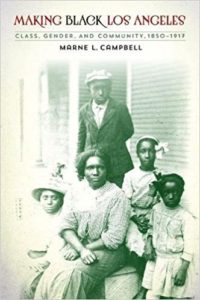“…when one looks closely, one finds a small, thriving black community that worked closely with other racial and ethnic communities in order to maintain itself. This early black community, made up almost entirely of working-class people, together with a very small elite class, created black Los Angeles.” — Marne Campbell, “Making Black Los Angeles”
In her new book, “Making Black Los Ang eles: Class, Gender, and Community, 1850-1917” (University of North Carolina Press, 2016), Loyola Marymount University professor Marne Campbell examines the social foundations forged by the city’s earliest African American settlers — beginning with a small group of 12 families in 1850 and growing to a thriving community of thousands by the early 1900s.
eles: Class, Gender, and Community, 1850-1917” (University of North Carolina Press, 2016), Loyola Marymount University professor Marne Campbell examines the social foundations forged by the city’s earliest African American settlers — beginning with a small group of 12 families in 1850 and growing to a thriving community of thousands by the early 1900s.
“I focus on 1850 because that’s when L.A. becomes an American city, and the first African Americans come at that time,” explained Campbell, a social historian and associate professor of African American Studies at LMU. Her work focuses on the middle 19th and early 20th century urban United States. “I think looking at this early period really helps us understand where we are today,” said Campbell. “I always tell my students, L.A. is one of the most diverse cities in the world. It’s also one of the most segregated, and it always has been.”
Campbell notes that many black Angelenos were originally brought to the city as slaves and later sued for their freedom under California’s constitution. Yet, though the state may have provided ostensible legal protection, it was by no means free from discrimination. “There’s the perception that California was racially tolerant, but it wasn’t. It never was. It’s just that black people were persistent, and very well organized.”
Campbell argues that much of the community’s success was due to black women, who created the social, religious and educational networks that enabled the community to flourish and access economic opportunities in the larger society. “Women did all of this work,” said Campbell. “They set the foundation for the rest of black LA that we see in most of the research.”
In researching her book, Campbell built an extensive database of nearly every African American family in Los Angeles between 1850 and 1910. She began with census data and cross-referenced primary source information from court records, baptism registries, memoirs and more — piecing together events and building a cohesive story as patterns began to emerge.
One story Campbell was particularly drawn to was that of a slave named Hannah, who, unlike some of her more famous contemporaries, struggled to gain her freedom and was nearly kidnapped and kept in slavery. “I like her story because I feel like it challenges what people think,” said Campbell. “Some people come, they get their freedom, and they live happily ever after. But for others, no, it was a hard life. This was a western town; it was dirty and gritty.”
Campbell is currently compiling a database of court records from the same period for her next project, a book on race and criminality in early Los Angeles. Other projects in the works include a book on the history of civil unrest in the U.S. and an article on women in the west.



